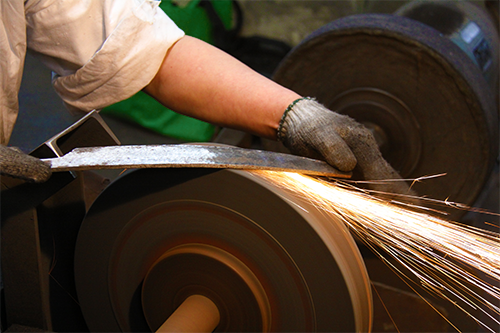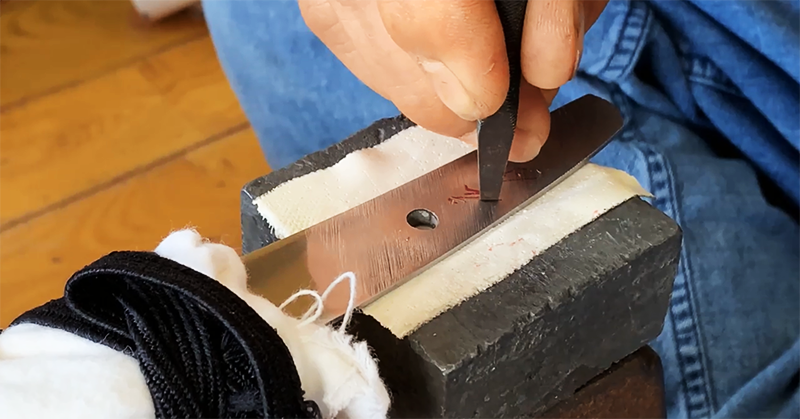About Us
Bizen Osafune is, located in eastern Okayama Prefecture, a place where blacksmiths who have trained Japanese swords gather. The Japanese sword, which was once forged at this place, exists as an important cultural asset of Japan. Sword blacksmiths who still inherits tradition and school (Cultural Agency / All Japan Swordsman Association certified) are training everyday. Also, once a year the Art Swordsman Skills Art Conservation Workshop will be held here. Even now, it is still the centerpiece of Japanese swords in Japan.
Among the many blacksmith smiths, who unleashes a remarkably distinctive color, Hiroyasu Ando imprints his soul on the Japanese-style knife sold at this website. Hiroyasu Ando completed the Art Swordsman-Takumi Art Conservation Workshop organized by the Agency for Cultural Affairs in 2002. In 2003, his works was selected for the exhibition. And then, he received an award for excellence at the “New Art Swords Exhibition” sponsored by the Japan Art Swords Conservation Association in 2017. He is one of the few sword blacksmiths with exceptional talent and delicate skills.
Japanese kitchen knives which are sold on this site, is a top-of-the-line products created by the collaboration of Swordsmith Hiroyasu Ando and soon to be the 5th-generation Japanese kitchen knife craftsman from Sakai. (This is a professional Japanese kitchen knife forged using Yaoki Aogami No. 2 steel, polished for sharpness and durability.)



Manufacturing process of Japanese kitchen knife (single-edge steel attached knife)
Heating process
- 1.Hagane-kiri
The blade steel is shaped and cut it into the correct amount for the knife.
- 2.Hagane-tuke
The blade steel is joined with base steel using Kinsetsuzai or special bond.
- 3.Wakashi-tuke
It is heated to between 800C - 900C for temporary adhesion.
- 4.Sakinobashi
The part which is going to be the top of knife is shaped.
- 5.Nakago-nobashi
The part of the end of the blade is shaped.
- 6.Sou-hidukuri
It is heated to make the final shape of the knife.
- 7.Yaki-namashi
It is then put in ash to cool down slowly avoiding any irregularities.
Finishing process
- 8.Beto-tori
The oxidized film or oxidized iron produced through heating process is removed.
- 9.Aratataki
The knife is on normal temperature to make it tighten.
- 10.Uramigaki
The face of the blade is polished.
- 11.Ji-tachi
Extra steel after hit is cut off.
- 12.Hon-narashi
The back is pounded to make the quality perfect.
- 13.Kokuin-uchi
The maker's name is stamped on the blade.
- 14.Kei-biki
The knife is put on the template to mark the correct size.
- 15.Kata-tachi
The excess is cut off to make it into the required shape.
- 16.Migari-mawashi
The rough edges are polished off with grinder or file.
- 17.Mae-shori
All oil or dirt is removed from the blace.
Annealing
- 18.Doro-nuri
Mud is put on the front to avoid oxidization and irregularities.
- 19.Yakiire
It is heated up to 800C and cool down in water.
- 20.Yakimodoshi
The same process is repeated to make the blade stronger.
- 21.Hizumi-uchi
Irrgularities that may have happened through this process are adjusted.
Polishing
- 22.Aragiri-hatogi
The blade on its front is polished with round roundpolish stone.
- 23.Ara-hira-togi
The whold front is polished.
- 24.Ara-ura-togi
The back is polished.
- 25.Ara-mune-togi
All through from the top to the end of blade is polished.
- 26.Hizumi-togi
Irregularities happened polishing process are ajusted.
- 27.Nakame-togi
It is polished with smoother stones.
- 28.Hafu-migaki
It is then polished with a cloth glued with diamond powder.
- 29.Kito-shiage
Diamond powder is put on the woden board to make line.
- 30.Kesyou-shiage
It is polished with whetstone powder to get the color.
- 31.Kobatuki-shiage
Then next it is polished the top delicately.
Making the handle
- 32.Genboku-kezuri
A dried piece of wood is curved into a correct size.
- 33.Kiwa-tuke
Then it is curved the part for a ring.
- 34.Ana-ake
A hole is made for the haft.
- 35.Wa-hame
Baffalo's horn is cut into the same size of the ring and pushed into the handle.
- 36.Migaki
Both the horn and the wood are polished till it gets smooth.
Finishing
- 37.E-tuke
The haft is heated and pounded into the handle.
- 38.Yugamitori-Kenpin
The whole balance is adjusted.
- 39.Bousei-shori
It is lubricated with anti rust paint.
- 40.Housou
It is packed into the box.
Please make sure that you read below before using the knife
- Bizen-Osafune knife comes with a sharp blade. Use the knife appropriately; don't use them for any other unintended purposes.
- If you use the knife for an unintended purpose, its blade can chip.
- If the blade is chipped, please sharpen properly.
- Defrost the frozen food before cutting them.
- Knife's handle may come off. Make sure to fasten any looseness before use.
- Stop using the knife If it produces unusual sounds or if you feel uncomfortable.
- It's dangerous to beat something brandishly with the knife.
- rivet-fastened handle might have gaps between tang and scales, causing the rivet(s) to come off.
- Store the knife in a safe place and don't let children use the knife without parental guidance.
- Don't place the knife on the heat source such or fire.
- Wash the knife thoroughly and hygienically carefully.
- Please sharpen the knife if its blade becomes dull. Don't neglect it; get it maintained.
- This knife is made of steel. Please wash it immaculately and keep it dry after use.
- To revive rusty knife, use both whetstone and metal polishing powder for maximum result.
- To store the knife for a long period of time, wrap its body with oil paper or rustproof paper, put it in a box, and keep it in a dry place.
Inscription
Inscription is to engrave a name on the knife's blade.In the case of a Japanese sword, the name of the producer is engraved on the core (Nakago: the sword's handle), but in the case of a kitchen knife it is engraved on the surface. At Bizen Osafune, customer's inscription is free of charge. When ordering, please enter the letters, that you want to engrave, in the Remarks column. Please note that cancellation after ordering a inscribed kitchen knife is not possible.
Character types that can be engraved as inscription
- Kanji, Hiragana, Katakana
- Alphabet
- Number
Inscription's Warning
- You can not specify a font because it is engraved by hand.
- You can not inscribe a picture.
- There is a limit to the number of characters because the space to make an inscription changes depending on the kitchen knife. Please contact us for more information.
- An inscribed knife can not be returned or exchanged after order.

